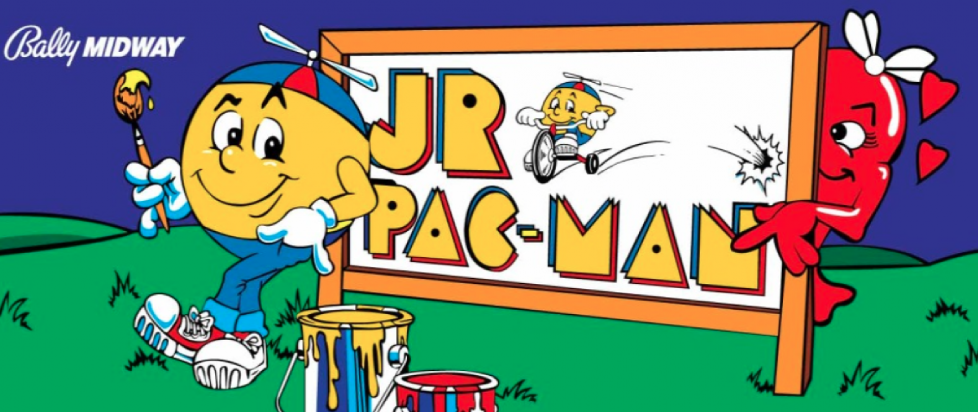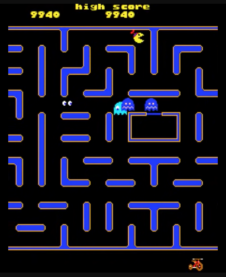
A Personal Account of Jr. Pac-Man, the GOAT Maze Chase Game
At Coin-Op Game Room in downtown Sacramento, I gazed at the new screen. I had never heard of Jr. Pac-Man. Probably a gimmick forgotten for good reason. Or maybe an enchanting curiosity. Twenty-five cents for the truth.
That first experience led me back to that machine many times over the last year.
I have always respected Pac-Man and Ms. Pac-Man, despite never being good at them. I admire their tight design, vibrant personality, and legendary accessibility. But Jr. Pac-Man has shown me what a maze chase should be – and reminded me of game history’s countless unexplored corners.
———
Speed kills, combat sports experts say. The faster you are, the better you can hit and avoid being hit. In the case of Jr. Pac-Man, your own speed can get you killed.
The protagonist of Jr. Pac-Man, propeller hat and all, makes his counterparts seem ancient. He can double back for missed pellets within kissing distance of a ghost before having to hightail it in the opposite direction. Situations that would doom Mr. and Ms. Pac-Man can lead to highlight-reel escapes for the youngster.
Jr. Pac-Man trades the excruciating anxiety of the original Pac-Man – when a ghost is almost on your ass, when only a magic pellet would save you – for arrogant displays of death-defying gusto. The hero’s speed can inspire fatal overconfidence, like a fighter who lets their arms down to coax an opponent into a mistake, only to eat a knockout punch to the jaw. I have become drunk on the quickness of Jr. Pac-Man. I have invited close calls, ruining promising playthroughs.
Then there’s the practical problem with higher speed: Turning onto another path in the maze requires better reflexes than in traditional Pac-Man games. Precise joystick movement is paramount in scenarios where you need to execute successive turns to evade the ghosts, who also move faster than their ancestors. Compared to its predecessors, Jr. Pac-Man is more like a racing game without brakes, where a missed turn can spell your end.
———
While the objective of Pac-Man – eat all the pellets to advance levels – carries over to Jr. Pac-Man, the latter is more sprawling.
Gone is the famous single-screen stage. Jr. Pac-Man uses scrolling to reveal mazes that stretch beyond our collective imagination of what a Pac-Man level should be. Warp tunnels – paths allowing travel from one side of the screen to the other – have no place here.

The extra space complements the hero’s increased speed in Jr. Pac-Man. The larger mazes are playgrounds of sorts, places where Jr. can poke around in and run amok. Jr. Pac-Man jettisons the profound sense of confinement from previous games. This time, you get to explore and digest the maze, almost as if you’re the temporary inhabitant of a world.
Efficient movement and pellet eating may not seem as crucial in these huge settings. But the bigger mazes contain more pellets, including an increase from four to six power pellets, the power-ups that let the hero devour ghosts for bonus points (if not for survival or satisfaction). Left-behind pellets don’t register as much of a nuisance in Pac-Man and Ms. Pac-Man – in those claustrophobic games, everything is practically around the corner. In Jr. Pac-Man, you must remember the pellet locations to maintain a decent level-clearing pace. That you can’t see all the remaining pellets on a single screen gives Jr. Pac-Man a more epic feel.
The lack of god-like vision in Jr. Pac-Man also creates urgency given the game’s devious bonus items. These point-granting items are no longer fruit, but as in Ms. Pac-Man, they move. And they can devastate your plans.
Pellets grow after the items touch them. Big pellets slow Jr. down, which can cause unexpected run-ins with ghosts. Even more concerning: Items can wipe a power pellet off the map with a suicidal explosion. And so, as the ghosts chase you, you must chase the items, even if you don’t want their points. The increased feeling of freedom (fun) in Jr. Pac-Man is packaged with irritating consequences.
The double-edged sword of the game’s setting is not unlike the situation in the game’s between-level cutscenes, where the outgoing protagonist gets the hots for Yum-Yum, a red ghost girl. What makes Jr. excited also draws ire from the kids’ respective families, Romeo and Juliet style.
The danger that comes with romance. It’s why Jr. Pac-Man captivates me more than any Pac-Man before it.
———
First date, May 21, 2022. From Peru. Couldn’t speak English. Yet she managed to be funny in a way most Americans can’t. I took her to Coin-Op. Introduced her to Jr. Pac-Man. You can learn a lot about someone based on their reaction to failure. The video of her dying as Jr. and smiling that big smile hasn’t left my phone. Nor has she left my life.

———
One night last year I popped a quarter into the Jr. Pac-Man machine and discovered chaos. The hero was red rather than yellow. The outer boundaries of the maze looked folded inward, creating a domed platform of a level like something out of a shroom eater’s hallucination. Sometimes Jr. would appear in a different corner of the maze after turning toward a new corridor. Warp tunnel eat your heart out.
My score suffered. My imagination didn’t. I relished the hell the game technician would fix.
———
For a not insignificant stretch of time, I was convinced the barcade had gotten rid of Jr. Pac-Man.
At the very least, the cabinet was removed from its original spot, and I failed to rediscover it until just a few weeks ago. Granted, for months Coin-Op has switched the locations of many machines while bringing in new games. It’s possible Jr. Pac-Man remained on the floor the whole time, though that seems unlikely given my multiple searches. (Yes, I could badger the staff for the official story, but a little mystery never killed anyone.)
The point is, Jr. Pac-Man has never, to my knowledge, been ported in its true arcade form since its 1983 release. When I felt my days of playing the Jr. Pac-Man machine were over, I thought about the popular gaming world’s lack of concern about lost, discarded, or replaced history. I thought about the death of Xbox Live Indie Games, an innovative platform that featured a number of fascinating games, like Platformance: Castle Pain and Light’s End, that are no longer playable. I thought about Golden Axe: The Revenge of Death Adder and The Punisher, two of the greatest 2D beat-‘em-ups that haven’t been properly translated for consoles (don’t even mention the Genesis version of The Punisher). I thought about the current remake craze – scores of people may never know what made certain games great in the first place due to our culture’s obsession with updates and overhauls.

You could say this extra bellyaching of mine proved unnecessary. I played Jr. Pac-Man multiple times while writing this article. But it’s still shameful Jr. Pac-Man hasn’t graced a collection for a well-known home system. Catherine Vice, a.k.a. Indie Gamer Chick, put it best when she lamented the status of the “historically-underrated” Jr. Pac-Man:
“I really wish whoever the hell owns the rights to this… would stop letting Jr. Pac-Man wallow in obscurity. How in the hell do we live in a world where Nintendo’s 1983 Baseball game has gotten over a dozen re-releases but Jr. Pac-Man hasn’t seen the light of day except, apparently, one Jakks Pacific plug-and-play that wasn’t even one of their more famous ones. God, it’s such a frustrating situation.”
Not every game historian is as fond of Jr. Pac-Man. Writing for Hardcore Gaming 101, Bobinator describes Jr. Pac-Man as a “rather forgettable spinoff,” criticizing its “much more meandering pace.”
But I will never forget the giant mazes, the daredevil-ish near collisions with enemies, the experimental attitude toward a standard. Like a classic Mario level, video game history contains secrets that become essential once found.
———
Jed Pressgrove is a game, movie, and technology critic. His work has appeared in Unwinnable Monthly, Slant, Paste, and Monkey Island Chronicles, the 30th anniversary Monkey Island book published by Limited Run Games. He’s been writing at his award-winning blog Game Bias since 2014.


